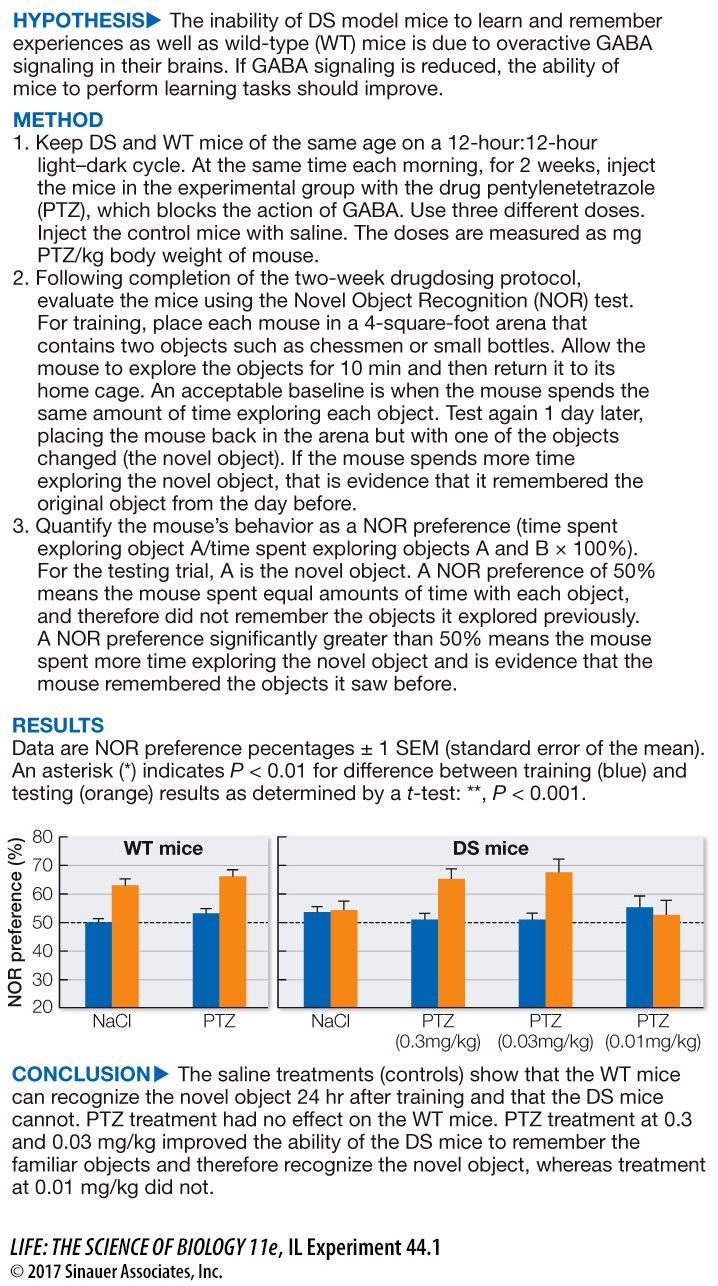The action of a neurotransmitter depends on the receptor to which it binds
More than 100 neurotransmitters are now recognized, and more will surely be discovered. Acetylcholine (ACh) is an important neurotransmitter because it is the substance the nervous system uses in signaling muscles to contract. ACh also plays roles in certain synapses between neurons in the brain, but it accounts for only a small percent of the total neurotransmitter content of the brain.
The workhorse neurotransmitters of the brain are three simple amino acids: glutamate, which is usually excitatory, and glycine and γ-aminobutyric acid (GABA), which are usually inhibitory. The integration of information at the cellular level is a balance between excitation and inhibition, so it is understandable that excessive inhibition such as you saw in the Down syndrome mice described at the start of this chapter could impair an animal’s ability to process and integrate new information. Indeed, when GABA’s inhibitory action in these mice was reduced by a drug that blocks the GABA receptor, the learning ability of the mice improved, as described in Investigating Life: Can Learning Be Restored in Mouse Models of Down Syndrome?
investigating life
Can Learning Be Restored in Mouse Models of Down Syndrome?
experiment
Original Paper: Colas, D., B. Chuluun, D. Warrier, M. Blank, D. Z. Wetmore, P. Buckmaster, C. C. Garner and H. C. Heller. 2013. Short-
If the learning disability in the mouse model of Down syndrome (DS) is due to overinhibition, then reducing the activity of the major inhibitory neurotransmitter, GABA, might improve learning in these mice.

work with the data
All of the PTZ injections in the experiment described above were given to the mice early in the light phase of their day. This is the time when these nocturnal animals are normally sleeping. The researchers therefore asked whether the same results could be obtained if the treatments were delivered during the dark phase of the day, when the mice are usually active and exploring. They obtained the following data:
| Treatment | ||
|---|---|---|
| Group | Saline | PTZ 0.3 mg/kg |
| WT Mice Training | 55.0 ± 3.1 | 55.4 ± 2.4 |
| DS Mice Training | 51.9 ± 2.4 | 50.7 ± 2.0 |
| WT Mice Testing | 65.8 ± 5.3* | 67.4 ± 4.9* |
| DS Mice Testing | 53.7 ± 4.7 | 51.3 ± 6.9 |
QUESTIONS
1.
How does the learning ability of the WT and DS mice compare during the dark phase of the day, and does this result differ from when the training and testing are done during the light phase?
During the dark phase the WT mice had significant discrimination scores during testing, indicating that they learned to recognize the training object. The DS mice did not have significant discrimination scores and thus did not learn. These were the same results as obtained during the light phase.
2.
Describe any difference between the effect of the PTZ treatment on the performance of the WT and DS mice on the NOR task during the light and dark phases of the day.
When the experiment was done during the dark phase, the results for the saline-
A similar work with the data exercise may be assigned in LaunchPad.
Another important group of neurotransmitters in the brain is the monoamines, which are derivatives of amino acids. They include dopamine and norepinephrine (derivatives of tyrosine) and serotonin (a derivative of tryptophan). Peptides also function as neurotransmitters; for example, endorphins and enkephalins are the body’s opiates and modulate the sensation of pain. Another peptide, substance P, transmits pain sensations. Even a gas, nitric oxide, is used by neurons as an intercellular messenger (see Figure 7.13).
Neurotransmission is complex in part because each neurotransmitter has multiple receptor types. ACh, for example, has two receptor types: nicotinic receptors and muscarinic receptors. All of the ACh receptors in skeletal muscle are nicotinic. Both types of ACh receptors are found in the brain and spinal cord, where nicotinic receptors tend to be excitatory and muscarinic receptors tend to be inhibitory. ACh actions can differ outside the brain and spinal cord as well. ACh acting through nicotinic receptors causes the smooth muscle of the gut to increase its motility, but ACh acting through muscarinic receptors causes cardiac muscle to hyperpolarize and therefore to slow down. There are many more examples of neurotransmitters that have different effects in different tissues, but the important thing to remember is that the action of a neurotransmitter depends on the receptor to which it binds. In addition, turning neurotransmitter action off is as important as turning it on.
Activity 44.2 Neurotransmitters